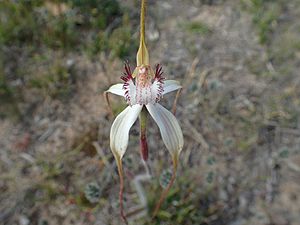Esperance white spider orchid facts for kids
Quick facts for kids Esperance white spider orchid |
|
|---|---|
 |
|
| Caladenia longicauda subsp. crassa growing near Munglinup | |
| Scientific classification |
|
| Kingdom: | Plantae |
| Clade: | Tracheophytes |
| Clade: | Angiosperms |
| Clade: | Monocots |
| Order: | Asparagales |
| Family: | Orchidaceae |
| Subfamily: | Orchidoideae |
| Tribe: | Diurideae |
| Genus: | Caladenia |
| Species: | |
| Subspecies: |
C. l. subsp. crassa
|
| Trinomial name | |
| Caladenia longicauda subsp. crassa Hopper & A.P.Br.
|
|
| Synonyms | |
|
Arachnorchis longicauda subsp.crassa (Hopper & A.P.Br.) D.L.Jones & M.A.Clem. |
|
The Esperance white spider orchid (its scientific name is Caladenia longicauda subsp. crassa) is a beautiful flower. It belongs to the orchid family. This special orchid only grows in the south-west part of Western Australia. This means it is endemic to that area.
This orchid has one fuzzy leaf. It usually grows up to three mostly white flowers. These flowers have long, wide parts called sepals and petals that spread out. The middle part of the flower, called the labellum, is quite wide and has small, narrow teeth. You can find this orchid growing along the south coast, between Bremer Bay and the Cape Arid National Park.
What Does It Look Like?
The Esperance white spider orchid is a ground-dwelling plant. It is a perennial herb, which means it lives for more than two years. It also loses its leaves at certain times of the year, making it deciduous. This orchid grows from an underground tuber (like a small potato).
It has a single hairy leaf that is about 12 to 25 centimeters (5 to 10 inches) long. The leaf is also about 8 to 14 millimeters (0.3 to 0.6 inches) wide.
The orchid produces up to three flowers. Each flower is mostly white and can be quite large, about 14 to 20 centimeters (5.5 to 8 inches) long. They are also about 7 to 14 centimeters (3 to 5.5 inches) wide. These flowers grow on a tall stem, or spike, that can be 25 to 50 centimeters (10 to 20 inches) tall.
The top sepal, called the dorsal sepal, and the two side sepals are 7 to 10 centimeters (3 to 4 inches) long. They start out linear or lance-shaped. Then, they become very thin and thread-like, often drooping downwards.
The labellum (the lip of the orchid) is shaped like a heart. It is mostly white and measures about 20 to 25 millimeters (0.8 to 1 inch) long. It is also 12 to 18 millimeters (0.5 to 0.7 inches) wide. The column (the central part of the flower) is fairly long, about 8 to 12 millimeters (0.3 to 0.5 inches).
In the center of the labellum, there are four or more rows of pale red bumps. These bumps are called calli. This orchid blooms from August to early October.
How It Got Its Name
The scientific name for this orchid, Caladenia longicauda, was first officially described in 1840. This description was made by a person named John Lindley. It was published in a book called A Sketch of the Vegetation of the Swan River Colony.
Later, in 2001, two scientists named Stephen Hopper and Andrew Brown studied this orchid more closely. They described eleven different types, or subspecies, of Caladenia longicauda. One of these was subspecies crassa. Their descriptions were published in a scientific journal called Nuytsia.
The subspecies name crassa comes from a Latin word. It means "thick" or "fat." This name was chosen because the sepals and petals of this orchid are quite wide near their bases.
Where It Lives
The Esperance white spider orchid grows in a specific area of Western Australia. You can find it between Bremer Bay and the Cape Arid National Park. This region includes several different biogeographic regions. These are areas with similar plants, animals, and environments. The regions where this orchid grows are the Esperance Plains, Jarrah Forest, Mallee, and Warren.
This orchid prefers to grow in areas with shrubland. Shrubland is land covered mostly by shrubs. It particularly likes places that get flooded with water during the winter months.
Looking After This Orchid
The Western Australian Government's Department of Parks and Wildlife keeps track of how many of these orchids exist. They have classified Caladenia longicauda subsp. crassa as "not threatened." This is good news, as it means the orchid is not currently in danger of disappearing.

